MARKETING
Pillar Pages: Why and How You Should Add Them to Your Content Strategy

The author’s views are entirely his or her own (excluding the unlikely event of hypnosis) and may not always reflect the views of Moz.
In a recent study, we found that our pillar pages are magnets for links, organic traffic, and newsletter subscribers — especially compared to regular blog posts. Here are the results that both types of SEO content generated over the course of a year:
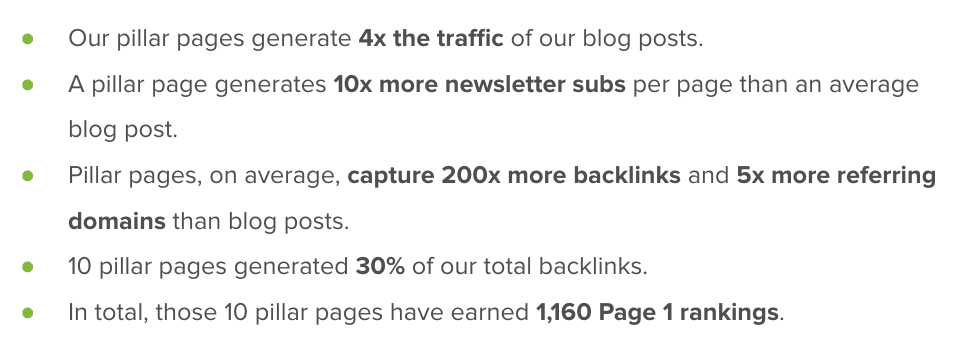
Do these results mean you should ditch your blog strategy in favor of pillar pages? Not exactly.
Here’s the catch: You really can’t have one without the other, and it all comes down to content mapping. I’ll explain exactly what I mean in this article.
What is a pillar page?
A pillar page is a piece of content that comprehensively covers a broad topic. Pillar page — also sometimes referred to as hub and spoke — content weaves together a wide range of relevant subtopics (spokes), organizes them all in one place (hub), and effectively showcases your subject matter expertise for the broad topic.
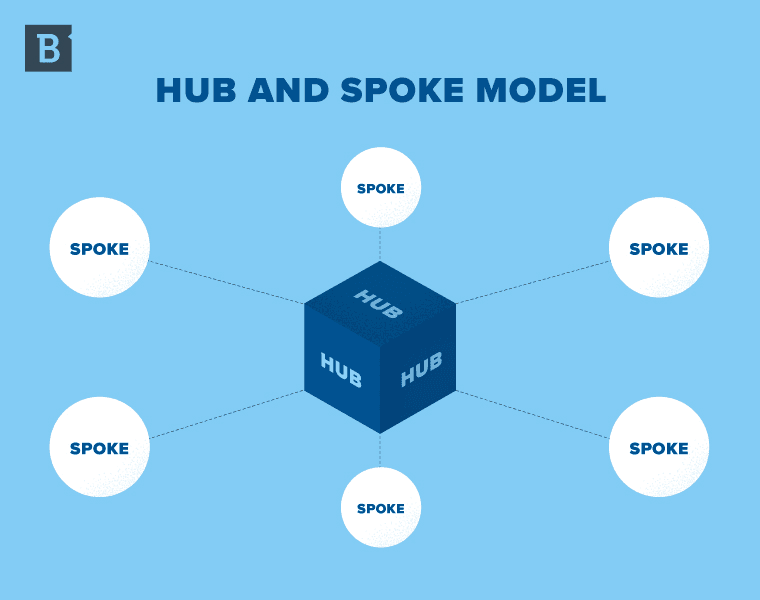
Pillar page content should be easy to navigate for readers looking to learn — at a high level — about a particular topic, but should also offer relevant resources for them to dive deeper.
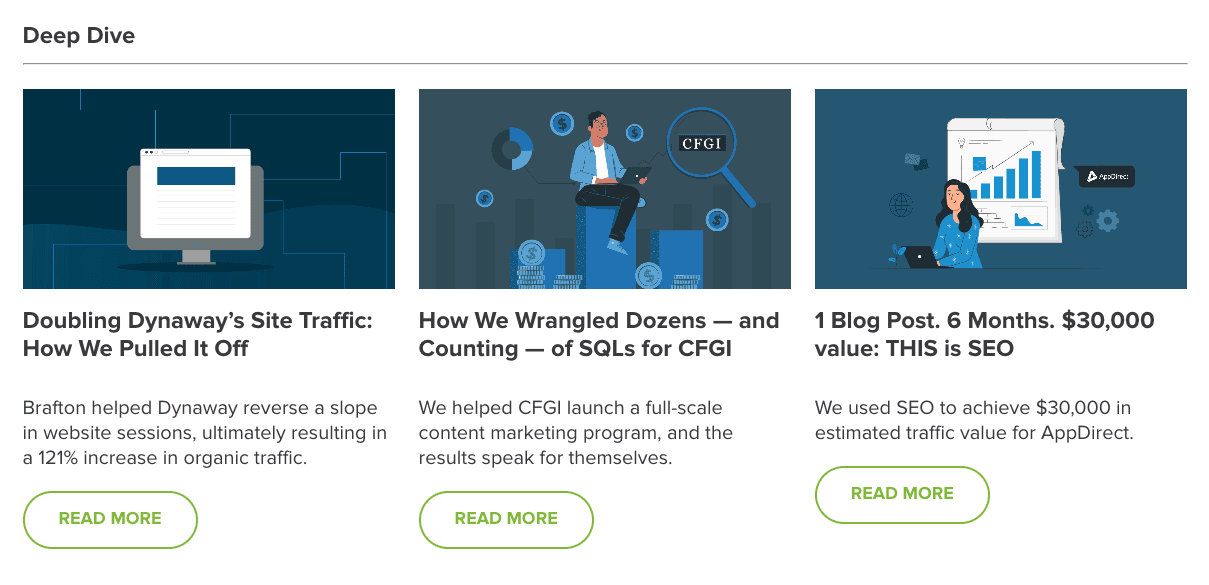
It’s kind of like the choose-your-own-adventure of content marketing.
Topical authority: why it’s important
When it comes to content creation for SEO and digital marketing, you don’t want to create content around any old topic. Instead, you want to reinforce your brand’s topical authority with every new piece of content you create (be it a blog, a pillar page, an eBook, etc.).
Let’s put it this way: If you’re in the business of selling mechanical keyboards, it doesn’t make sense to publish a blog article about the best recipes for a summer BBQ. Unless you’re recommending that your customers grill and eat their mechanical keyboards, which is (highly) unlikely.
Instead, it’s more helpful to your brand — and your audience — if you cover topics related to mechanical keyboards, like:
-
What is a mechanical keyboard?
-
Mechanical keyboards vs. regular keyboards.
-
Custom mechanical keyboards.
-
How to transition to a mechanical keyboard.
-
Pros and cons of a mechanical keyboard.
By covering as many topics related to mechanical keyboards as possible, you’re building a foundation of informational content that tells search engines: “Hey, I know a lot about mechanical keyboards!”
And the more content you have that starts to rank for important search terms related to mechanical keyboards, the more likely searchers will see you as an authority on the subject. Ideally, they will start coming back to your content when they need to learn more about this specific topic.
Pillar pages + blogs = a match made in content marketing heaven
A well-executed and organized pillar page is one of the best ways to showcase to your audience (and search engines) that you have topical authority in a specific area. Blog posts help you achieve topical authority by allowing you to cover a wide range of relevant subtopics in great detail, and pillar pages organize all of that content into a nice, user-friendly package.
Let’s take a look at this tactic in action.
We built our content marketing guide as a pillar page, which allowed us to cover a slew of subtopics related to the broader topic of content marketing, all in one piece of collateral.
All of these subtopics are organized into sections on the page, with a hyperlinked table of contents at the top to allow readers to pick and choose exactly what they’d like to learn about:
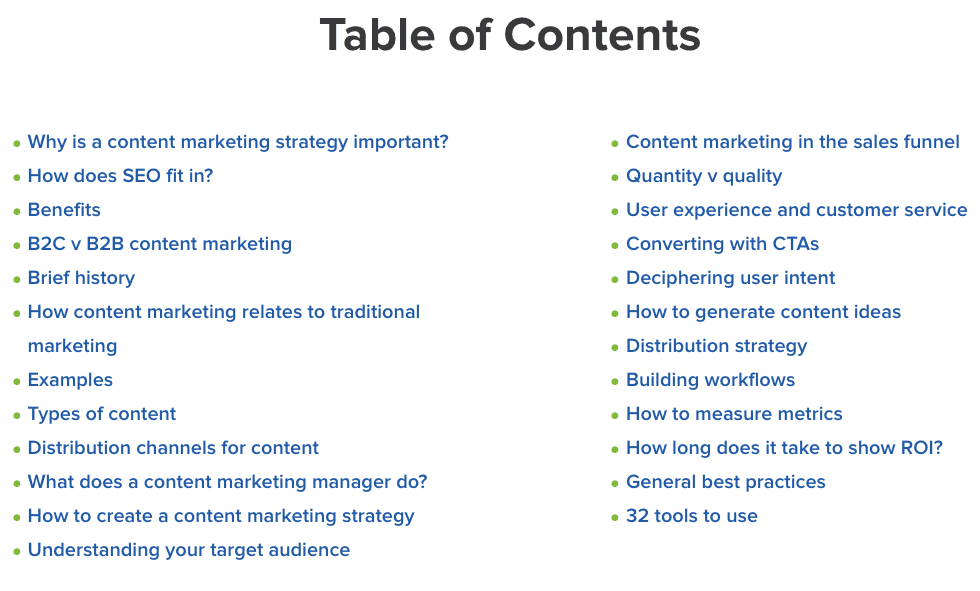
Then, throughout the page, we offer readers the opportunity to go deeper and learn more about each subtopic by linking to relevant blog content:
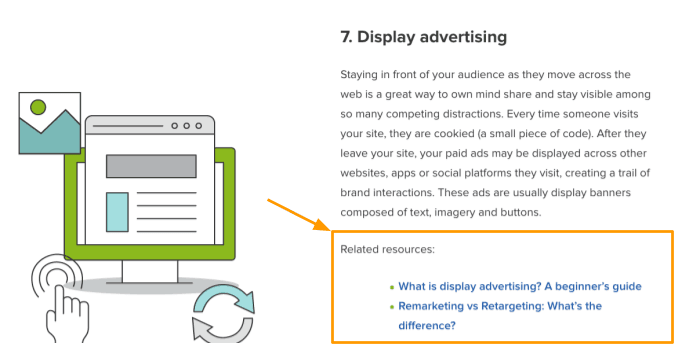
What is content mapping?
A pillar page is a great tactic if you’ve got a lot of existing blog content all focused on a particular parent topic. It’s one of our favorite ways at Brafton to repurpose and repromote our blogs.
But you can also create a pillar page with all brand-new content — it’ll just take more research, planning, and production time to complete.
Enter: content mapping.
Content mapping is the process of assessing your target audience, understanding what they are trying to achieve, and helping them along that journey with branded educational and commercial content. Its scope can span the entirety of your content marketing strategy or a single piece of pillar page content.
Why content mapping matters in content marketing
The planning (or content mapping) of a pillar page is just as important as the research done to choose the correct keyword to target for your business.
Pillar pages are kind of like the books of the marketing world. If you were an expert birder, for example, you wouldn’t set out to write a book about bird-watching without doing any research. Especially if you’ve spent a lot of time writing and publishing articles about bird-watching on your blog. You’d want to understand a few things before starting that book, like:
-
Which of my blog posts generated the most interest from new and returning readers? (i.e. pages with the most new and returning visitors, as seen in your web analytics tool).
-
Which blogs kept readers coming back for more? (i.e. pages with the most newsletter subscriptions, or the best newsletter subscription rates).
-
Which blogs did my industry peers find most useful? (i.e. pages with the greatest number of high-quality referring domains and backlinks).
These questions can be answered by looking through your web analytics tools, such as Google Analytics and Moz Pro.
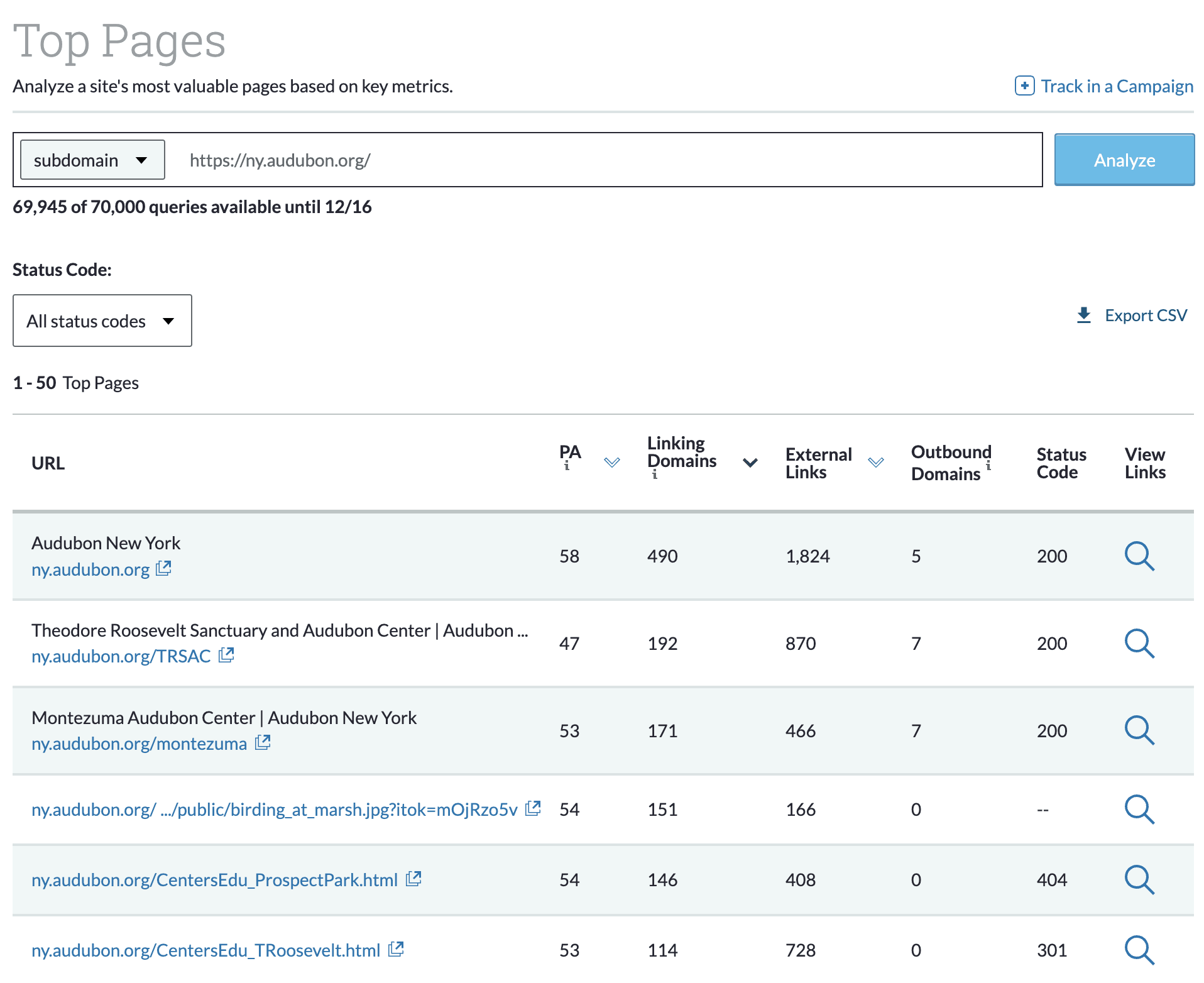
You’d also want to understand what the competition looks like before you spend dozens of hours writing thousands of words to fill a book.
You’d want to answer questions, like:
-
What do my competitors’ books on bird-watching look like? (i.e. the types of bird-watching subtopics the page 1 results cover).
-
What does Google think searchers want to see when they search for bird-watching? (i.e. the types of content that are found on page 1 for your target keyword — and surprise! it might not be books).
-
How long and detailed are my competitors’ books? (i.e. the level of complexity and comprehensiveness of the content ranking on page 1).
These questions can be answered by manually reviewing relevant SERPs and utilizing TF-IDF tools like Clearscope or MarketMuse to understand the breadth of subtopics and types of content ranking on the first page.
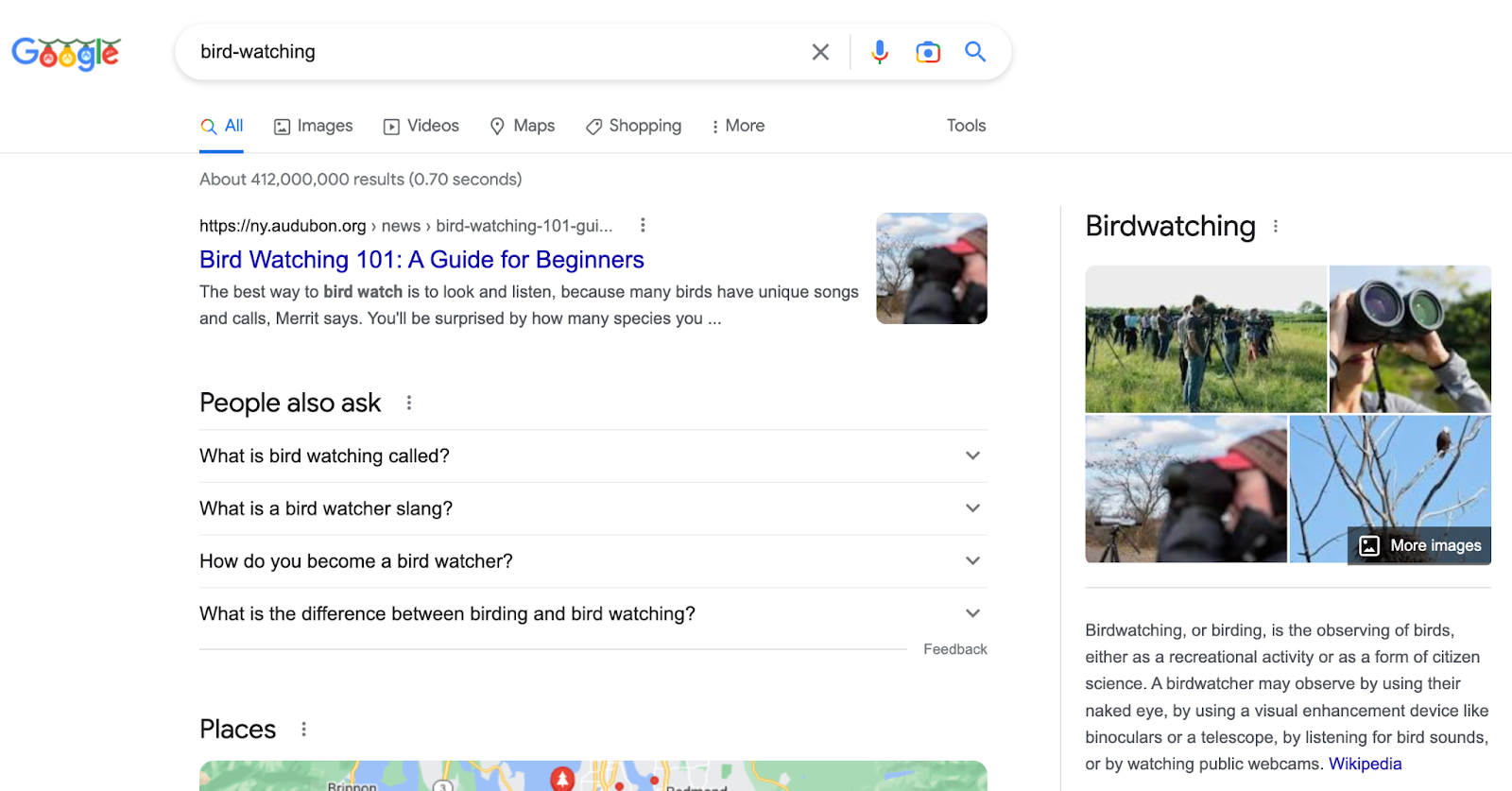
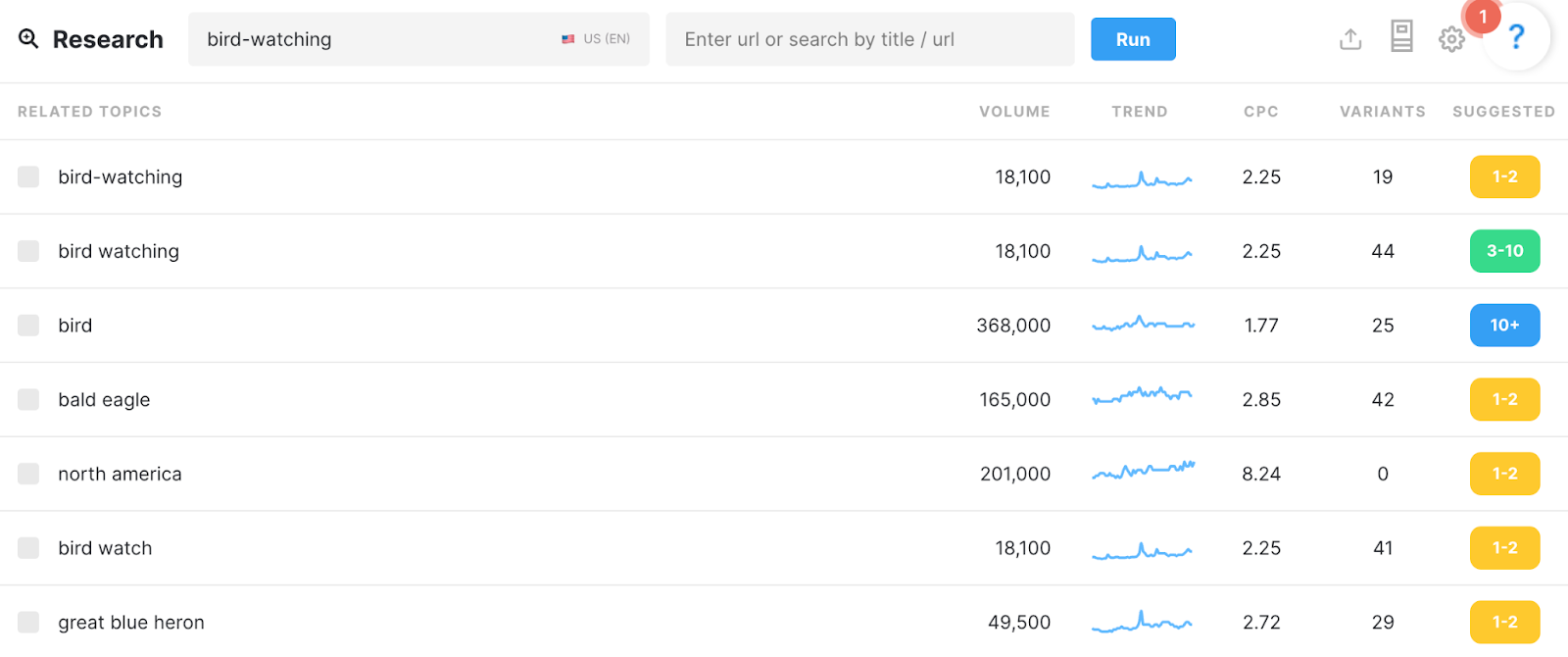
Once you understand which of your content performs best and which content Google and other search engines prefer to rank highly for your target keyword, you can start piecing together a plan for your pillar page.
A note about internal linking
Before we dive into the how-to portion of this piece, we should also acknowledge the importance of internal linking to this whole process.
And I’m not just talking about throwing in a link to a related product/service at the end of the page and calling it a day. The internal linking structure of your pillar page is literally the glue that holds the whole thing together. It helps readers easily navigate to related resources to continue learning from your brand. And it helps search engines understand the relationship between your pillar page content and the additional content you’re highlighting on the page.
But when it comes to internal linking, there is such a thing as too much of a good thing.
Including too many internal links throughout your content can cause a frustrating user experience or look spammy, so use caution and make sure the only internal linking you do on the page is extremely relevant to the parent topic.
If you’re unsure whether or not you’ve got too many internal links on the page, you can run it through Moz’s On-Page Grader tool, which automatically counts the number of links on your page and flags if you’ve got too many.
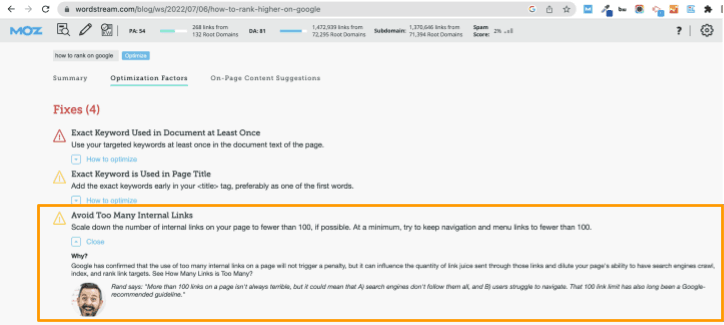
Tip: Keep in mind that this tool will count ALL links found on the page, including those in your main navigation and footer, so the “Too Many Links” warning could be a false positive.
As Moz explains: Google recommends you don’t go over 100 internal links per page, because it can dilute the SEO value sent from the pillar page to the linked pages, and it can also make it more challenging for users and crawlers to navigate all of the content.
Two data-led ways to map out content for a pillar page
There are a couple of different ways to approach the construction of this type of content, but they each rely on organic search data to lead the way.
1. Planning a pillar page and related resources (all from scratch)
Let’s pretend you don’t have any prior content created about a particular topic. You’re basically starting from scratch. Let’s also assume the topic you’ve selected is both core and commercially valuable to your business, and that your domain realistically has a chance of ranking on page 1 for that keyword.
Let’s say you’re a pet food company and one of your main products is cat dental treats. Once you’ve determined that this is the exact keyword you want to target (“cat dental treats”), it’s time to start your research.
Step 1: Manually inspect SERP to understand searcher intent
First, we’ll start by manually inspecting the first SERP for this keyword, and answering the following questions:
-
What types of content are on the first page of results?
-
Why are people searching for “cat dental treats”?
By answering these two questions in our SERP analysis, we’ll make sure that our plan for creating a pillar page to rank actually makes sense and it’s what searchers want to see on the SERP. We’ll also better understand all the reasons behind why someone might search this keyword (and we can then address those reasons in the content we create).
So let’s answer these questions:
Question 1: What types of content are on the first page of results?
Answer 1: The first SERP includes a variety of product ads, a People Also Ask section, and a selection of organic blogs and product pages.

Question 2: Why are people searching for “cat dental treats”?
Answer 2: From a quick analysis of the SERP, we can deduce that people want to know why and how cat dental treats are important to a cat’s health, and they also want to know which cat dental treats work best. Perhaps most importantly, it’s highly likely that they plan to purchase cat dental treats for their furry companion(s) in the near future.
Step 2: Select related keyword ideas for blog content
Since you don’t just want to create a pillar page for just the primary keyword, you also want to pinpoint a selection of related subtopics to be written as blog content.
For this part of the process, head over to your keyword research tool, plug in your target keyword and (with an eye for topics that you’re well-suited to cover), jot down a list of keywords and phrases.
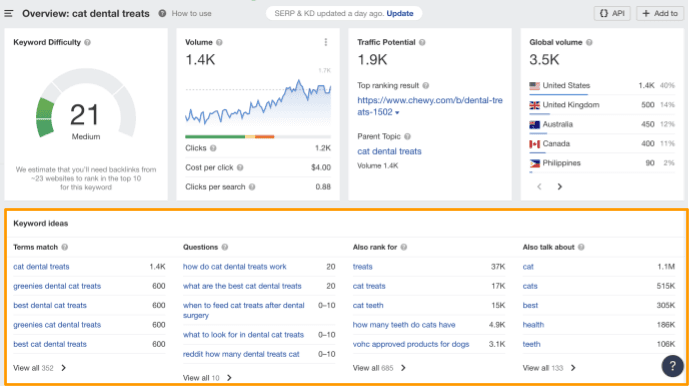
Here’s our list of potential blog topics:
-
Best cat dental treats.
-
How do cat dental treats work?
-
What to look for in cat dental treats.
-
Do cat dental treats work?
-
Can cat dental treats replace brushing?
-
Vet recommended cat dental treats.
-
Grain-free cat dental treats.
Step 3: Choose subtopics to cover in your pillar page content
Next, you’ll want to review the subtopics mentioned in the top ranking results. While this process can be done manually (by clicking into each result on the SERP and jotting down the topics mentioned), a TF-IDF tool like MarketMuse makes this part of the process much quicker:
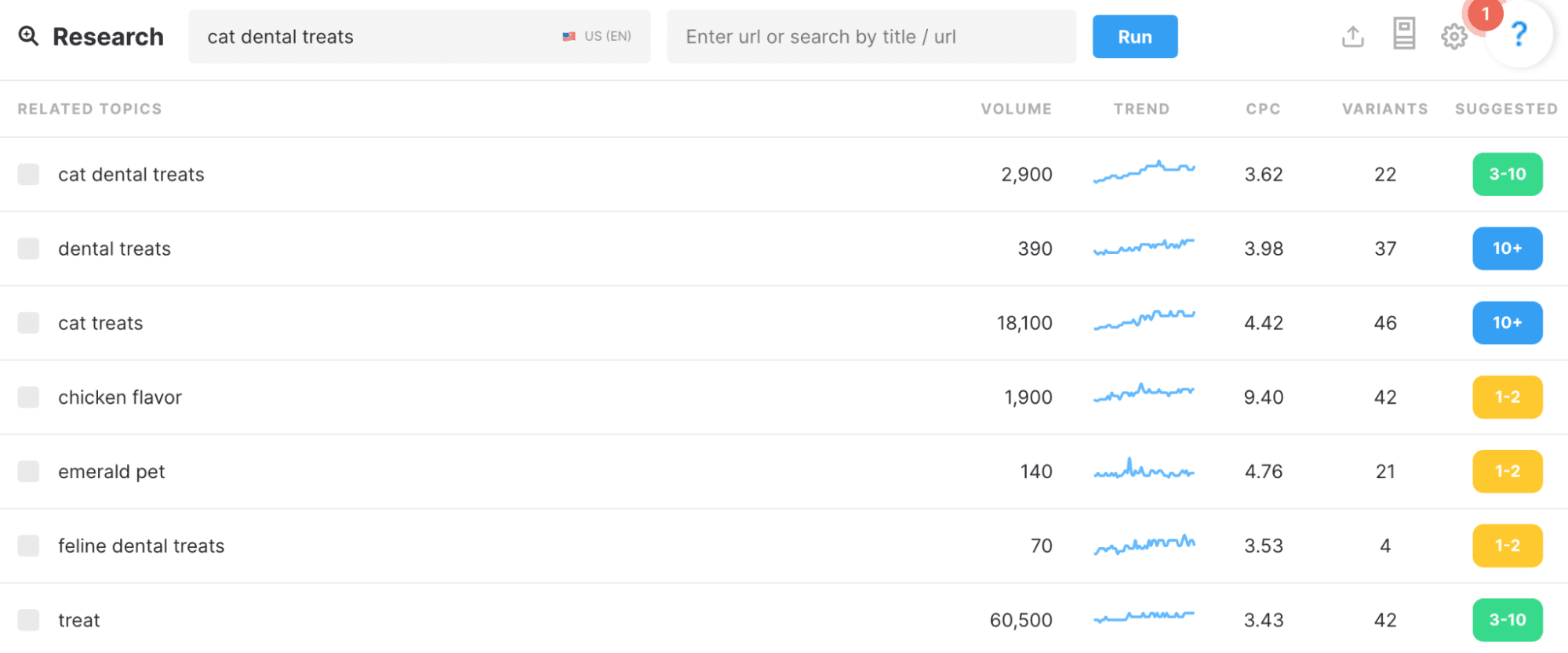
These TF-IDF tools analyze the top 10-20 results for your target keyword and automatically present the common subtopics mentioned in each piece. This gives you a very good understanding of what you’ll also need to cover in your piece to compete for a top-ranking spot.
Here’s the list of subtopics we’ll want to cover in this pillar page, based on our MarketMuse data:
Step 4: Create your outline and plan content
Now it’s time to connect the dots from your research. The best way to do this is to start by structuring your pillar page outline, and then going back in and filling in the areas where you want to create supporting blog content.
Here’s an example of what the end result might look like:
H1: The Complete Guide to Cat Dental Treats: For a Fresh-Breath Feline Friend
H2: What are cat dental treats and how do they work?
- Topics to cover: Cat dental treats
- Blog post to support section:
Title: How Cat Dental Treats Work (& Why Your Kitty Needs Them)
Keyword: how do cat dental treats work
H2: What are the benefits of cat dental treats?
- Topics to cover: Clean teeth, fresh breath
- Blog post to support section:
Title: Do Cat Dental Treats Really Work? (Here’s What The Experts Say)
Keyword: do cat dental treats work
H2: Are cat dental treats an acceptable alternative to brushing?
- Topics to cover: Cats dental health
- Blog post to support section:
Title: Cat Dental Treats Vs Brushing: Everything You Need To Know
Keyword: can cat dental treats replace brushing
H2: Do vets recommend using cat dental treats?
- Topics to cover: Veterinary oral health council
- Blog post to support section:
Title: Vets Recommend Using Cat Dental Treats — Here’s Why
Keyword: vet recommended cat dental treats
H2: The best cat dental treats to try
- Topics to cover: Purina dentalife, Feline greenies, natural ingredients, artificial flavors.
- Blog post to support section:
Title: 5 Of The Best Cat Dental Treats & Why We Love Them
Keyword: best cat dental treats - Blog post #2 to support section:
Title: What To Look For In Cat Dental Treats
Keyword: what to look for in cat dental treats
Creating an outline for a pillar page isn’t easy, but once laid out, it helps us understand the content that needs to be produced to bring the whole thing to life.
Here is our list of content to create (based on our outline):
-
Pillar page: The Complete Guide to Cat Dental Treats: For a Fresh-Breath Feline Friend
-
Blog #1: How Cat Dental Treats Work (& Why Your Kitty Needs Them)
-
Blog #2: Do Cat Dental Treats Really Work? (Here’s What The Experts Say)
-
Blog #3: Cat Dental Treats Vs Brushing: Everything You Need To Know
-
Blog #4: Vets Recommend Using Cat Dental Treats — Here’s Why
-
Blog #5: 5 Of The Best Cat Dental Treats & Why We Love Them
-
Blog #6: What To Look For In Cat Dental Treats
The best way to tackle this list of content is to create and publish the six blog posts first, then once they are live, you can write the pillar page content, placing hyperlinks to the supporting blog posts directly in the copy.
2. Planning a pillar page from top performing content
For this next method, let’s say you already have a ton of published content about a particular topic, and you’d like to reuse and repromote that content within a pillar page dedicated to that topic.
All of the steps in the previous process apply, but for Step 2 (Select Related Keyword Ideas for Blog Content), do the following:
First, you’ll want to understand which of your existing pieces generates the most interest from your audience. Let’s use our web analytics data for this. In this example, we’ll look at Google Search Console data because it shows the actual search performance of our website content.
Let’s use the topic of “content creation” as our desired pillar page keyword. Search for the query in Google Search Console (choose the “Queries containing” option):

Pull all of the pages currently generating impressions and clicks from terms containing your topic, placing those with the highest clicks and impressions at the top of your list. Here’s what this might look like:

As you can see, most of the content we’ve created that also ranks for keywords containing “content creation” is blog content. These will be highly useful as related resources on our pillar page.
Now, go back to your TF-IDF tool and select the subtopics related to “content creation” that you want to cover in your pillar page. Example:
-
Social media content
-
Content creation tool
-
Content creators
-
Content strategy
-
Content creation process
Finally, map your existing blog content to those “content creation” subtopics. The initial mapping may look something like this:

You may not be able to map each blog perfectly to the subtopic you’re covering in your pillar page, but that’s OK. What’s important is that you’re providing readers with relevant content (where applicable) and that content, as you’ve seen in your Search Console data, is already proven to perform well with your organic search audience.
Pillar page planning templates and resources
Pillar pages take an incredible amount of time and planning to execute, but they are worth every penny.
Here’s an example of the success we saw after producing one of our more recent pillar pages, “How to Rank on Google:”
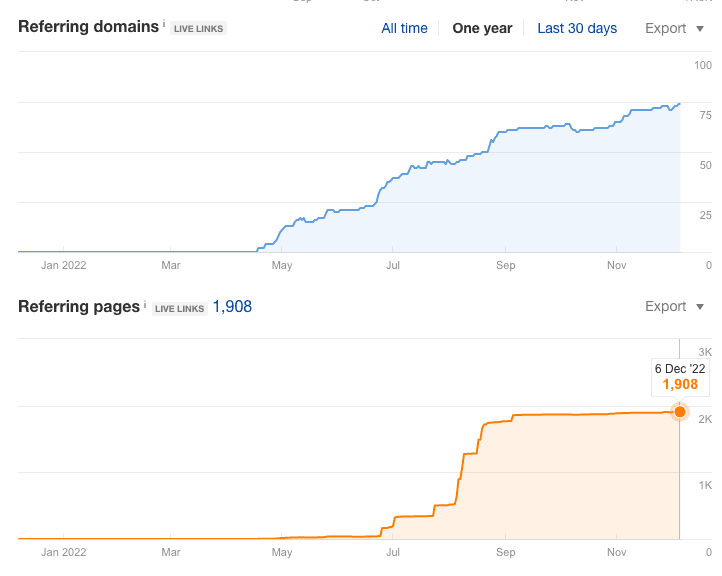
Here’s a template of the outline used to bring the page to life (and you can use it for your own pillar page). Just make a copy and off you go. Good luck!
MARKETING
Tinuiti Marketing Analytics Recognized by Forrester

Rapid Media Mix Modeling and Proprietary Tech Transform Brand Performance
Tinuiti, the largest independent full-funnel performance marketing agency, has been included in a recent Forrester Research report titled, “The Marketing Analytics Landscape, Q2 2024.” This report comprehensively overviews marketing analytics markets, use cases, and capabilities. B2C marketing leaders can use this research by Principal Analyst Tina Moffett to understand the intersection of marketing analytics capabilities and use cases to determine the vendor or service provider best positioned for their analytics and insights needs. Moffett describes the top marketing analytics markets as advertising agencies, marketing dashboards and business intelligence tools, marketing measurement and optimization platforms and service providers, and media analytics tools.
As an advertising agency, we believe Tinuiti is uniquely positioned to manage advertising campaigns for brands including buying, targeting, and measurement. Our proprietary measurement technology, Bliss Point by Tinuiti, allows us to measure the optimal level of investment to maximize impact and efficiency. According to the Forrester report, “only 30% of B2C marketing decision-makers say their organization uses marketing or media mix modeling (MMM),” so having a partner that knows, embraces, and utilizes MMM is important. As Tina astutely explains, data-driven agencies have amplified their marketing analytics competencies with data science expertise; and proprietary tools; and tailored their marketing analytics techniques based on industry, business, and data challenges.
Our Rapid Media Mix Modeling sets a new standard in the market with its exceptional speed, precision, and transparency. Our patented tech includes Rapid Media Mix Modeling, Always-on Incrementality, Brand Equity, Creative Insights, and Forecasting – it will get you to your Marketing Bliss Point in each channel, across your entire media mix, and your overall brand performance.
As a marketing leader you may ask yourself:
- How much of our marketing budget should we allocate to driving store traffic versus e-commerce traffic?
- How should we allocate our budget by channel to generate the most traffic and revenue possible?
- How many customers did we acquire in a specific region with our media spend?
- What is the impact of seasonality on our media mix?
- How should we adjust our budget accordingly?
- What is the optimal marketing channel mix to maximize brand awareness?
These are just a few of the questions that Bliss Point by Tinuiti can help you answer.
Learn more about our customer-obsessed, product-enabled, and fully integrated approach and how we’ve helped fuel full-funnel outcomes for the world’s most digital-forward brands like Poppi & Toms.
The Landscape report is available online to Forrester customers or for purchase here.
MARKETING
Ecommerce evolution: Blurring the lines between B2B and B2C

Understanding convergence
B2B and B2C ecommerce are two distinct models of online selling. B2B ecommerce is between businesses, such as wholesalers, distributors, and manufacturers. B2C ecommerce refers to transactions between businesses like retailers and consumer brands, directly to individual shoppers.
However, in recent years, the boundaries between these two models have started to fade. This is known as the convergence between B2B and B2C ecommerce and how they are becoming more similar and integrated.
Source: White Paper: The evolution of the B2B Consumer Buyer (ClientPoint, Jan 2024)
What’s driving this change?
Ever increasing customer expectations
Customers today expect the same level of convenience, speed, and personalization in their B2B transactions as they do in their B2C interactions. B2B buyers are increasingly influenced by their B2C experiences. They want research, compare, and purchase products online, seamlessly transitioning between devices and channels. They also prefer to research and purchase online, using multiple devices and channels.
Forrester, 68% of buyers prefer to research on their own, online . Customers today expect the same level of convenience, speed, and personalization in their B2B transactions as they do in their B2C interactions. B2B buyers are increasingly influenced by their B2C experiences. They want research, compare, and purchase products online, seamlessly transitioning between devices and channels. They also prefer to research and purchase online, using multiple devices and channels
Technology and omnichannel strategies
Technology enables B2B and B2C ecommerce platforms to offer more features and functionalities, such as mobile optimization, chatbots, AI, and augmented reality. Omnichannel strategies allow B2B and B2C ecommerce businesses to provide a seamless and consistent customer experience across different touchpoints, such as websites, social media, email, and physical stores.
However, with every great leap forward comes its own set of challenges. The convergence of B2B and B2C markets means increased competition. Businesses now not only have to compete with their traditional rivals, but also with new entrants and disruptors from different sectors. For example, Amazon Business, a B2B ecommerce platform, has become a major threat to many B2B ecommerce businesses, as it offers a wide range of products, low prices, and fast delivery
“Amazon Business has proven that B2B ecommerce can leverage popular B2C-like functionality” argues Joe Albrecht, CEO / Managing Partner, Xngage. . With features like Subscribe-and-Save (auto-replenishment), one-click buying, and curated assortments by job role or work location, they make it easy for B2B buyers to go to their website and never leave. Plus, with exceptional customer service and promotional incentives like Amazon Business Prime Days, they have created a reinforcing loyalty loop.
And yet, according to Barron’s, Amazon Business is only expected to capture 1.5% of the $5.7 Trillion addressable business market by 2025. If other B2B companies can truly become digital-first organizations, they can compete and win in this fragmented space, too.”
If other B2B companies can truly become digital-first organizations, they can also compete and win in this fragmented space
Joe AlbrechtCEO/Managing Partner, XNGAGE
Increasing complexity
Another challenge is the increased complexity and cost of managing a converging ecommerce business. Businesses have to deal with different customer segments, requirements, and expectations, which may require different strategies, processes, and systems. For instance, B2B ecommerce businesses may have to handle more complex transactions, such as bulk orders, contract negotiations, and invoicing, while B2C ecommerce businesses may have to handle more customer service, returns, and loyalty programs. Moreover, B2B and B2C ecommerce businesses must invest in technology and infrastructure to support their convergence efforts, which may increase their operational and maintenance costs.
How to win
Here are a few ways companies can get ahead of the game:
Adopt B2C-like features in B2B platforms
User-friendly design, easy navigation, product reviews, personalization, recommendations, and ratings can help B2B ecommerce businesses to attract and retain more customers, as well as to increase their conversion and retention rates.
According to McKinsey, ecommerce businesses that offer B2C-like features like personalization can increase their revenues by 15% and reduce their costs by 20%. You can do this through personalization of your website with tools like Product Recommendations that help suggest related products to increase sales.
Focus on personalization and customer experience
B2B and B2C ecommerce businesses need to understand their customers’ needs, preferences, and behaviors, and tailor their offerings and interactions accordingly. Personalization and customer experience can help B2B and B2C ecommerce businesses to increase customer satisfaction, loyalty, and advocacy, as well as to improve their brand reputation and competitive advantage. According to a Salesforce report, 88% of customers say that the experience a company provides is as important as its products or services.
Market based on customer insights
Data and analytics can help B2B and B2C ecommerce businesses to gain insights into their customers, markets, competitors, and performance, and to optimize their strategies and operations accordingly. Data and analytics can also help B2B and B2C ecommerce businesses to identify new opportunities, trends, and innovations, and to anticipate and respond to customer needs and expectations. According to McKinsey, data-driven organizations are 23 times more likely to acquire customers, six times more likely to retain customers, and 19 times more likely to be profitable.
What’s next?
The convergence of B2B and B2C ecommerce is not a temporary phenomenon, but a long-term trend that will continue to shape the future of ecommerce. According to Statista, the global B2B ecommerce market is expected to reach $20.9 trillion by 2027, surpassing the B2C ecommerce market, which is expected to reach $10.5 trillion by 2027. Moreover, the report predicts that the convergence of B2B and B2C ecommerce will create new business models, such as B2B2C, B2A (business to anyone), and C2B (consumer to business).
Therefore, B2B and B2C ecommerce businesses need to prepare for the converging ecommerce landscape and take advantage of the opportunities and challenges it presents. Here are some recommendations for B2B and B2C ecommerce businesses to navigate the converging landscape:
- Conduct a thorough analysis of your customers, competitors, and market, and identify the gaps and opportunities for convergence.
- Develop a clear vision and strategy for convergence, and align your goals, objectives, and metrics with it.
- Invest in technology and infrastructure that can support your convergence efforts, such as cloud, mobile, AI, and omnichannel platforms.
- Implement B2C-like features in your B2B platforms, and vice versa, to enhance your customer experience and satisfaction.
- Personalize your offerings and interactions with your customers, and provide them with relevant and valuable content and solutions.
- Leverage data and analytics to optimize your performance and decision making, and to innovate and differentiate your business.
- Collaborate and partner with other B2B and B2C ecommerce businesses, as well as with other stakeholders, such as suppliers, distributors, and customers, to create value and synergy.
- Monitor and evaluate your convergence efforts, and adapt and improve them as needed.
By following these recommendations, B2B and B2C ecommerce businesses can bridge the gap between their models and create a more integrated and seamless ecommerce experience for their customers and themselves.
MARKETING
Streamlining Processes for Increased Efficiency and Results

How can businesses succeed nowadays when technology rules? With competition getting tougher and customers changing their preferences often, it’s a challenge. But using marketing automation can help make things easier and get better results. And in the future, it’s going to be even more important for all kinds of businesses.
So, let’s discuss how businesses can leverage marketing automation to stay ahead and thrive.
Benefits of automation marketing automation to boost your efforts
First, let’s explore the benefits of marketing automation to supercharge your efforts:
Marketing automation simplifies repetitive tasks, saving time and effort.
With automated workflows, processes become more efficient, leading to better productivity. For instance, automation not only streamlines tasks like email campaigns but also optimizes website speed, ensuring a seamless user experience. A faster website not only enhances customer satisfaction but also positively impacts search engine rankings, driving more organic traffic and ultimately boosting conversions.
Automation allows for precise targeting, reaching the right audience with personalized messages.
With automated workflows, processes become more efficient, leading to better productivity. A great example of automated workflow is Pipedrive & WhatsApp Integration in which an automated welcome message pops up on their WhatsApp
within seconds once a potential customer expresses interest in your business.
Increases ROI
By optimizing campaigns and reducing manual labor, automation can significantly improve return on investment.
Leveraging automation enables businesses to scale their marketing efforts effectively, driving growth and success. Additionally, incorporating lead scoring into automated marketing processes can streamline the identification of high-potential prospects, further optimizing resource allocation and maximizing conversion rates.
Harnessing the power of marketing automation can revolutionize your marketing strategy, leading to increased efficiency, higher returns, and sustainable growth in today’s competitive market. So, why wait? Start automating your marketing efforts today and propel your business to new heights, moreover if you have just learned ways on how to create an online business
How marketing automation can simplify operations and increase efficiency
Understanding the Change
Marketing automation has evolved significantly over time, from basic email marketing campaigns to sophisticated platforms that can manage entire marketing strategies. This progress has been fueled by advances in technology, particularly artificial intelligence (AI) and machine learning, making automation smarter and more adaptable.
One of the main reasons for this shift is the vast amount of data available to marketers today. From understanding customer demographics to analyzing behavior, the sheer volume of data is staggering. Marketing automation platforms use this data to create highly personalized and targeted campaigns, allowing businesses to connect with their audience on a deeper level.
The Emergence of AI-Powered Automation
In the future, AI-powered automation will play an even bigger role in marketing strategies. AI algorithms can analyze huge amounts of data in real-time, helping marketers identify trends, predict consumer behavior, and optimize campaigns as they go. This agility and responsiveness are crucial in today’s fast-moving digital world, where opportunities come and go in the blink of an eye. For example, we’re witnessing the rise of AI-based tools from AI website builders, to AI logo generators and even more, showing that we’re competing with time and efficiency.
Combining AI-powered automation with WordPress management services streamlines marketing efforts, enabling quick adaptation to changing trends and efficient management of online presence.
Moreover, AI can take care of routine tasks like content creation, scheduling, and testing, giving marketers more time to focus on strategic activities. By automating these repetitive tasks, businesses can work more efficiently, leading to better outcomes. AI can create social media ads tailored to specific demographics and preferences, ensuring that the content resonates with the target audience. With the help of an AI ad maker tool, businesses can efficiently produce high-quality advertisements that drive engagement and conversions across various social media platforms.
Personalization on a Large Scale
Personalization has always been important in marketing, and automation is making it possible on a larger scale. By using AI and machine learning, marketers can create tailored experiences for each customer based on their preferences, behaviors, and past interactions with the brand.
This level of personalization not only boosts customer satisfaction but also increases engagement and loyalty. When consumers feel understood and valued, they are more likely to become loyal customers and brand advocates. As automation technology continues to evolve, we can expect personalization to become even more advanced, enabling businesses to forge deeper connections with their audience. As your company has tiny homes for sale California, personalized experiences will ensure each customer finds their perfect fit, fostering lasting connections.
Integration Across Channels
Another trend shaping the future of marketing automation is the integration of multiple channels into a cohesive strategy. Today’s consumers interact with brands across various touchpoints, from social media and email to websites and mobile apps. Marketing automation platforms that can seamlessly integrate these channels and deliver consistent messaging will have a competitive edge. When creating a comparison website it’s important to ensure that the platform effectively aggregates data from diverse sources and presents it in a user-friendly manner, empowering consumers to make informed decisions.
Omni-channel integration not only betters the customer experience but also provides marketers with a comprehensive view of the customer journey. By tracking interactions across channels, businesses can gain valuable insights into how consumers engage with their brand, allowing them to refine their marketing strategies for maximum impact. Lastly, integrating SEO services into omni-channel strategies boosts visibility and helps businesses better understand and engage with their customers across different platforms.
The Human Element
While automation offers many benefits, it’s crucial not to overlook the human aspect of marketing. Despite advances in AI and machine learning, there are still elements of marketing that require human creativity, empathy, and strategic thinking.
Successful marketing automation strikes a balance between technology and human expertise. By using automation to handle routine tasks and data analysis, marketers can focus on what they do best – storytelling, building relationships, and driving innovation.
Conclusion
The future of marketing automation looks promising, offering improved efficiency and results for businesses of all sizes.
As AI continues to advance and consumer expectations change, automation will play an increasingly vital role in keeping businesses competitive.
By embracing automation technologies, marketers can simplify processes, deliver more personalized experiences, and ultimately, achieve their business goals more effectively than ever before.
-

 SEARCHENGINES7 days ago
SEARCHENGINES7 days agoGoogle Core Update Volatility, Helpful Content Update Gone, Dangerous Google Search Results & Google Ads Confusion
-

 SEO7 days ago
SEO7 days ago10 Paid Search & PPC Planning Best Practices
-

 MARKETING5 days ago
MARKETING5 days ago5 Psychological Tactics to Write Better Emails
-

 SEARCHENGINES6 days ago
SEARCHENGINES6 days agoWeekend Google Core Ranking Volatility
-

 MARKETING6 days ago
MARKETING6 days agoThe power of program management in martech
-

 SEO6 days ago
SEO6 days agoWordPress Releases A Performance Plugin For “Near-Instant Load Times”
-
SEARCHENGINES4 days ago
Daily Search Forum Recap: April 15, 2024
-

 PPC5 days ago
PPC5 days ago20 Neuromarketing Techniques & Triggers for Better-Converting Copy
















You must be logged in to post a comment Login